Ethnobotany Test One • Name:
I. Matching: Write letters under correct image below.
Place the letter for the correct name of the plant under the picture of the plant. Write the name in your language (local name), if any. Your cultural group might no longer have a name for the plant. If so, then leave the item blank. Write down a use for the plant in Micronesia. The use can be from any culture.
A. Bird's Nest Fern B. Cyanobacteria C. Lycopodium cernuum
D. Microsorum scolopendria E. Moss F. Vittaria
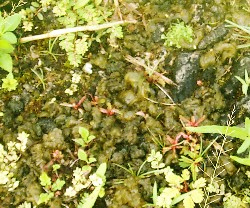
|
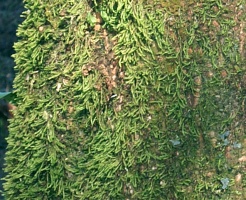
|
| Balls of green jelly found on rocky ground in the sun. | Found on rocks near rivers, on tree trunks, and in the shade. |
| 1. _____ | 2._____ |
| Local name: | Local name: |
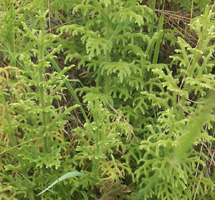
|
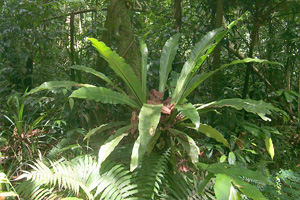
|
| Found on sunny hilltops beyond the gym | Found growing only on trees |
| 3. _____ | 4._____ |
| Local name: | Local name: |
| Local use: | Local use: |
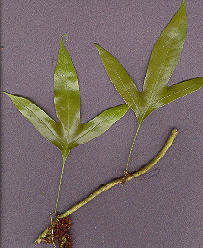
|

|
| Found growing on trees, including coconut palms. Also grows on the ground. | Found growing only on old trees, always hangs down. |
| 5. _____ | 6. _____ |
| Local name: | |
| Local use: | Local use: |
Linguistic matching
| 7. _____ Club moss | A. Chuukese |
| 8. _____ Kidi en mal | B. English |
| 9. _____ La'law | C. Kosraen |
| 10. _____ Lycopodium cernuum | D. Latin |
| 11. _____ Mac in tefuroh | E. Pohnpeian |
| 12. _____ Unen katu | F. Yapese |
II. Short Answer
- What organism is able to convert nitrogen (N2 gas) in the air into nitrogenous compounds usable by plants and animals?
- What is the function of the vegetative cell in the balls of green jelly found on rocky ground in the sun?
- Can we tell by looking the difference between male and female moss plants?
- Put the following into order from the botanically most "primitive" to most "evolved": cyanobacteria, ferns, lycopodium, mosses.
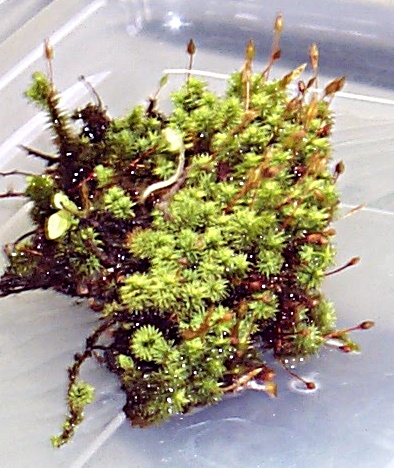 In the image of the moss to the right, what is the function of the long stalks that come up from the moss and end in a capsule? On living moss the stalks and capsule are usually brown.
In the image of the moss to the right, what is the function of the long stalks that come up from the moss and end in a capsule? On living moss the stalks and capsule are usually brown.- Mosses are unusual among plants in that the green part we see is haploid. All other plants we encounter in this course are diploid. What do the terms haploid and diploid mean?
- What is the difference between a gametophyte and a sporophyte?
- As a human being, are you a gametophyte or sporophyte?
- Where can I find Nostoc?
- Name the parts A, B, and C, of the Huperzia phlegmaria shown using botanically correct terms.
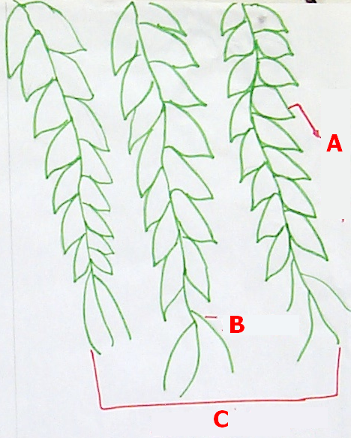 A: ______________
A: ______________
B: ______________
C: ______________
- What do the cones on a lycopodium and selaginella produce as part of their reproductive cycle?
- What is the meaning of a culture bound syndrome?
- Give an example of a culture bound syndrome ( can be from your culture or from that spoken about by the guest speaker).
- Cross-cultural toughies: What is the name, if any, of the following plants in your own language:
gob u láey: ______________
muhlihklihk: ______________
pwisehn ketipen: ______________
unen katu: ______________
III. Paragraphic answers
Paragraph: The mosses and lycopodium we have been studying are united by some common reproductive features. What are those common features?
Comment on the guest lecture by Dr. Michael Balick of the New York Botanic Garden. Was the presentation interesting? Would you recommend that he speak to future ethnobotany classes? Why?








 In the image of the moss to the right, what is the function of the long stalks that come up from the moss and end in a capsule? On living moss the stalks and capsule are usually brown.
In the image of the moss to the right, what is the function of the long stalks that come up from the moss and end in a capsule? On living moss the stalks and capsule are usually brown. A: ______________
A: ______________